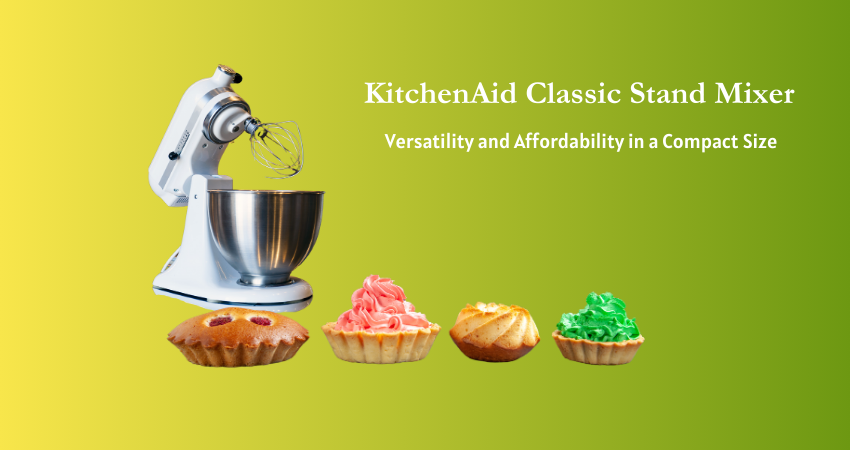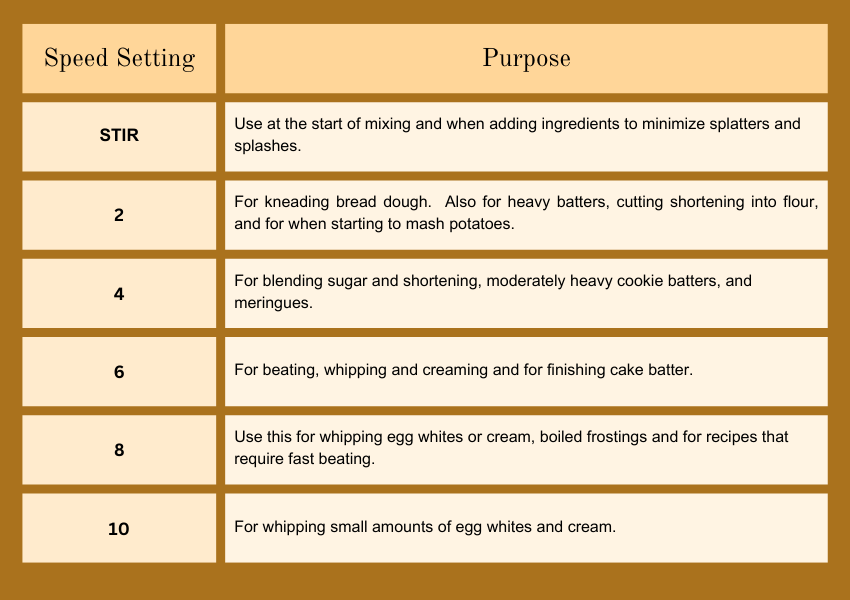Notice: I receive compensation if you buy something through affiliate links on this post. This does not change the price you would pay.

This KitchenAid Classic stand mixer review will explore what makes this no-frills model a reliable choice for those seeking dependability and affordability.
But wait.
Will it be enough for your baking needs, or will it fall short?
Should you prioritize price or capability?
How would you know?
You have landed on the right page because this review digs into every aspect of the KitchenAid Classic mixer—its power, capacity, performance, features, reliability, durability, and limitations.
After reading this review, you can determine whether the Classic model provides the value, reliability, and versatility you seek.
Let’s dive in.
Key Takeaways About the KitchenAid Classic
- The 275-watt motor is sufficient for light to moderate mixing, such as cake batters and cookie dough, creaming, whipping, and single batches of regular bread dough. Not for very dense dough like bagels.
- Its 4.5-quart bowl is adequate for smaller batches of dough, cookies, or batter. It holds up to 8 dozen cookies.
- It has 10-speed settings for slow stirring, mixing, whipping, and kneading.
- The tilt-head provides easy access to the bowl.
- Planetary mixing action and 59 touchpoints ensure thorough mixing.
- Includes nylon-coated beater, dough hook, and wire whisk.
- It has a power hub for various optional attachments such as a pasta maker, shredder, and meat grinder.
Contents
- 1 KitchenAid Classic Stand Mixer Review: Motor Performance
- 2 Capacity and Mixing Performance
- 3 KitchenAid Classic Stand Mixer Review: Functionality
- 4 Build Quality of the Classic KitchenAid Mixer
- 5 Care, Cleaning, and Regular Maintenance
- 6 Price And Warranty
- 7 Pros
- 8 Cons
- 9 User Reviews and Ratings
- 10 Should You Get A KitchenAid Classic Mixer?
KitchenAid Classic Stand Mixer Review: Motor Performance
The 275-watt, 120-volt AC motor can handle all mixing tasks except kneading very dense dough. It can tackle up to two recipes of regular bread dough, but not daily.
The Role of Torque
My first stand mixer came with a dough hook. Cool. I can also make bread without straining my hands, so I thought. But, it just struggled. It stalled and stopped.
Why? It has low torque.
Torque? What is it? It is the twisting force that turns objects around.
A mixer’s toque is not measured. It can only be assessed based on performance.
A high torque means a mixer can handle demanding mixing and kneading well.
On a scale of low to high, the KitchenAid Classic’s torque is moderate. It can knead bread dough, but not dense ones, and only small batches infrequently.
Go to this post for a detailed explanation of torque.
Overhead Motor Design
Have you ever wondered why KitchenAid stand mixers have heads?
Well, the mixer head holds the motor. Thus, the motor is called an overhead motor.
Other stand mixer brands, like Bosch, have their motors on the base.
How does the motor’s location affect a stand mixer’s performance?
Stand mixers with overhead motors are less stable because the base and the stand have to support a heavy weight on top. That is why they can shake or move with heavy loads.
On the other hand, a base motor mixer is supported by the motor’s weight, keeping it stable.
Cord Length
Most of us don’t pay attention to cord length.
I didn’t. Not until I needed to plug my stand mixer into another nearby electrical outlet.
It’s not a problem with the Classic KitchenAid because its 48-inch power cord with a three-prong plug gives you enough length to maneuver around your kitchen.
We know what this mixer’s power can do, but how many cookies or cakes can it handle?
Let’s find out…
Capacity and Mixing Performance
Bowl Capacity
The 4.5-quart bowl is made of brushed stainless steel.
The size is enough for a home baker who makes smaller batches of dough, cookies, or batters for a small family, and it works well for most everyday baking.
I have two sons, and one pastry recipe daily is enough for us. My husband is only interested in bread.
Although it can yield eight dozen cookies, I would only go as many as 5 to 6 dozen in a single batch. My two boys will have enough cookies for three days with five dozen.
I prefer to always use my mixer below its declared capacity, especially with thick cookie dough. This precaution is worth taking to prolong the life of my mixer.
4.5 quarts is not for large-volume baking for a crowd or a bake sale.
The bowl has no handle, making pouring inconvenient, especially if it’s filled or the mixture is sticky.
For convenience, a 5-quart bowl with a handle compatible with KitchenAid tilt-head models is available on Amazon.
But you can live with the no-handle bowl if you only prepare single to double recipes.
A glass bowl is not available for this stand mixer.
What about performance? Do you have to do a lot of manual mixing?
Read on to find out.
Mixing Performance
So, the Classic has ample power and capacity, but how well does it mix?
The mixer’s planetary mixing action mimics the movement of the planets around the sun.

I can almost hear you thinking: What do the planets have to do with mixing performance?
Let’s have a bit of science.
The beater, wire whip, or dough hook of the Classic KitchenAid stand mixer spins on the beater shaft as it moves around the bowl. It resembles a planet rotating on its axis while revolving around the sun.
As the mixer does its planetary mixing act, the beater moves to the side of the bowl, touches one point, moves back, and repeats the movement. It touches 59 points in the bowl in one revolution.
The planetary mixing action and 59 touchpoints ensure uniform and thorough mixing.
KitchenAid Classic Stand Mixer Review: Functionality
Tilt-Head Design
The Classic tilt-head mixer provides easy access to the accessories, bowl, and ingredients. Its head can be raised up and back to attach or detach accessories, remove the bowl, or mix ingredients by hand mid-mix.
Here’s how to do it:
- Unlatch the locking pin securing the head to the mixer’s stand.
- Gently lift the motor head.
- Lower the mixer’s head down after attaching or removing accessories or mixing by hand.
- Lock the head to the stand before running the mixer.
CAUTION!
Before turning on the mixer, ensure that the motor head is locked securely; otherwise, it will bob and shake.
Let’s move to another essential feature of mixers: speed.
Speed Settings of the Classic KitchenAid Mixer
This mixer has 10 speed settings, printed in increments of 2 on the side of the motor head. Below the speed settings is the speed lever selector. To set the speed, move it to the desired level.
If this mixer has ten speeds, where are the odd-numbered speed levels? They are not shown but are between the printed even-numbered speeds.
Is there a discernible difference between odd and even-numbered speeds? Yes, there is. Having ten speed settings allows you to fine-tune your speed requirement.
In addition to the 10 speed levels, there is a “STIR” speed or “slow start.” This speed is for slowly incorporating ingredients.
Always use the “STIR” function at the start. Be careful when moving the speed lever. I accidentally slid the lever of my KitchenAid mixer to a higher speed several times, and ingredients were thrown at my face.
Refer to the table below to learn which speed level to use for specific mixing techniques.

As for noise level, it’s not quiet but not loud enough to wake the entire household. It gets louder at higher speeds and more load.
Versatility With Accessories and Attachments
Accessories
The Classic KitchenAid stand mixer includes a nylon-coated C-shaped dough hook and flat beater and the standard 6-wire whip.
Here are the uses for specific accessories:
I suggest you get their Flex Edge scraper beater, which has a flexible edge on one side. This solves the oft-repeated complaint of manually scraping content off the bowl.
There is also a scraper beater with two flexible sides. But it may cause drag on the mixer.
One scraper edge is sufficient.
Another accessory that you can buy separately is a pouring shield. It prevents flour puffs and lessens the mess. However, you have to remove it if you scrape the bowl. It’s better if you have the scraper beater, too.
You can get replacements for all accessories from KitchenAid or Amazon.
Are there other available attachments?
The answer is in the next section.
Other Attachments
Several optional attachments provide KitchenAid stand mixers versatility, setting it apart from other brands.
The plus side is you don’t have to buy another appliance that will take up storage space. However, using attachments is more work for the motor.
Consider the Artisan if you intend to use several attachments.
Also, some attachments cost almost the same or more than a separate machine.
Here are some attachments you can use with the Classic stand mixer…
- Ice Cream Maker
- Pasta Roller
- Citrus Juicer
- Fruit/Vegetable Strainer
- All-Metal Grain Mill
- Food Grinder
- Rotor Slicer/Shredder
- Thick Noodle Cutter
- Angel Hair Pasta Attachment
- Gourmet Pasta Attachment
Before operating, make sure any attachment is securely connected to the power hub in front of the head. Then, thoroughly read and follow the instructions in the manual.
It’s cool to have other ways to use this mixer, but how sturdy is it?
That’s our next topic.
Build Quality of the Classic KitchenAid Mixer
Stability and Noise Level

Is this mixer a loudmouth?
It’s not quiet, but it won’t wake up your household when it’s running.
Does it dance on the counter?
I frequently read complaints about stand mixers shaking or walking.
To prevent such an issue, the first thing to do is ensure the locking pin is engaged securely.
This stand mixer is sturdy enough to stay grounded if used within its capacity and limits for everyday home baking.
Don’t overload it because it may vibrate and move with very dense or heavy loads.
Will this stand mixer last for years with proper use?
Let’s get to that next.
Durability
KitchenAid is a brand known for building quality and durable kitchen appliances. Its stand mixers are all made in the USA. It is the top stand mixer brand, with countless users, from novice to professional bakers.
The Classic mixer carries that reputation. It is made of a solid metal housing and coated with baked enamel. It is durable and lasts for years or even decades.
An all-metal body provides heft to keep the mixer steady during operation.
The bowl is durable brushed stainless steel, which usually outlasts the mixer.
The beater and dough hook are nylon-coated and, with proper care, will last years.
Do you wonder if it will fit in your kitchen? Then, proceed to the next section for the answer.
Dimensions and Storage
The KitchenAid Mixer Classic weighs 23.19 pounds and measures 14.1″ in diameter, 8.7” wide, and 13.9″ tall. It takes up slightly over one square foot of space.
It’s not light, but it’s manageable. However, you won’t want to lift it daily. A dedicated space on the counter, a low shelf, or a low cabinet will work.
The tilt-head design increases the height by approximately 3 inches. This should be considered if your working or storage space is underneath a cabinet.
Color Options And Gifting Possibilities
KitchenAid offers two sleek and versatile shades for the Classic K45SS stand mixer: Onyx Black and White.
Onyx Black has a sleek, professional appearance that suits a modern, elegant kitchen. It’s perfect for a kitchen with a contemporary or even industrial vibe.
On the other hand, if you lean toward a clean and classic look, White brings a touch of brightness and fits into almost any kitchen design, whether it’s a cozy farmhouse-style kitchen or a modern setup.
Brides often request KitchenAid stand mixers as wedding gifts. The Classic model is also an excellent gift for life milestones such as birthdays and graduations because it’s practical and durable.
If your recipient likes to bake and cook, they’ll be thrilled to receive a KitchenAid stand mixer.
Let’s tackle proper care next
Care, Cleaning, and Regular Maintenance
Caring for and cleaning the Classic mixer is simple.
Make sure to unplug the unit before cleaning.
Wipe the body and the mixer head, including the base, with a damp cloth after each use. Remove any residue on the beater shaft.
The bowl, coated dough hook, and flat beater can be washed in a dishwasher or in warm, sudsy water. Rinse thoroughly with water and dry completely.
Do not wash the wire whip in the dishwasher. Wash it by hand.
All accessories and attachments must be stored separately. Do not leave the beater, hook, or whip on the shaft.
I like to cover my kitchen appliances, especially if I use them sparingly. Covers keep away dust and can act as decor. Some folks prefer to display their KitchenAid stand mixers.
Covered or uncovered, just make sure to keep your stand mixer clean always.
You should also periodically maintain your KitchenAid K45ss to keep it in good shape.
Find out what to do next.
Regular Maintenance
Aside from regular wiping and washing, you can take a few steps to avoid expensive repairs and keep your Classic KitchenAid mixer running smoothly.
Inspect the Cord
Check the cord regularly to ensure it’s in good condition. If you find any frays or damage, stop using the mixer until it’s repaired. You can have it repaired by a professional or by KitchenAid service.
Lubricate Occasionally
Lubricate the gears occasionally, especially if you use the mixer frequently or for heavy-duty mixing. Check the video below for instructions. If you can’t do it, call a professional service.
Check for Wear and Dirt on the Power Hub
If you’ve been using attachments, inspect the power hub. Sometimes, food particles can get lodged inside, or attachments can wear down. Clean any dirt build-up with a soft brush or compressed air. Keeping the hub clean will ensure that attachments fit snugly and aren’t damaged.
Avoid Overloading
Overloading strains the mixer. Stress on the stand mixer parts builds up until something fails.
To avoid it, mix smaller amounts, stick to Speed 2, and be mindful of mixing time when using the mixer for dough.
Next, we’ll explore whether this 4.5-quart stand mixer fits your budget.
Price And Warranty

Price
With a mid-range price for stand mixers, the KitchenAid Classic offers excellent value for consumers seeking a reliable and durable mixer for everyday tasks like baking, dough making, and whipping.
It includes essential features such as a 275-watt motor, a 4.5-quart stainless steel bowl, and standard accessories. These features are sufficient for most home bakers and offer versatility.
However, while it delivers solid performance, it lacks advanced features found in higher-end models, such as overload protection and a slow start.
Consumers who want advanced functionality may find the price unjustified compared to more feature-rich models in the KitchenAid lineup.
Therefore, it presents good value for those focused on basic mixing tasks and comfortable with the simple design. However, those seeking additional versatility or higher-end performance should consider investing in a premium model.
Warranty
KitchenAid will replace a defective K45SS Classic mixer within one year of purchase or delivery.
Or, it will shoulder the costs of replacing defective parts or correcting manufacturing defects and their associated labor costs.
Authorized KitchenAid service centers or professional services can perform needed repairs.
Pros
- Reliable Performance: Efficient at mixing various ingredients, from doughs to cakes and cookies, saving time and effort compared to hand mixers.
- Durability and Stability: All-metal housing makes it stable and a long-term investment.
- Ease of Use: Intuitive design with simple controls.
- Versatility: The power hub for attachments expands its use for pasta making, grinding, and more.
- Tilt-Head Feature: Provides easy access to the bowl and accessories, simplifying ingredient addition, mixing, and changing accessories.
- Time-Saving: The Classic completes mixing tasks faster than a hand mixer or hand mixing.
- Compact: Easy to move around and fits smaller kitchen spaces.
- Affordable: A strong draw for those who seek a well-known brand at a lower price point.
- Popular Choice for Gifting: Frequently praised as a thoughtful and useful gift for cooking and baking enthusiasts, even for beginners.
- Positive Long-Term Reviews: Many users report satisfaction with the mixer, often noting it as a great investment for everyday kitchen tasks and even professional use.
Cons
- Limited Motor Power: The 275-watt motor may struggle with dense or heavy dough.
- No Overload Protection: The lack of overload protection makes it vulnerable to damage if overused or if the motor is pushed too hard with heavier mixtures.
- Smaller Bowl Capacity: The 4.5-quart bowl limits mixing to smaller volumes.
- Noisy at Higher Speeds: While quieter than some competitors, the mixer can still be noisy at higher speeds.
- Basic Aesthetic: The design and color options (Onyx Black and White) are basic shades, which may not appeal to those who love pops of color.
- Limited Warranty: The 1-year warranty is short compared to some competitors, which raises concerns for long-term reliability.
User Reviews and Ratings
There are a fair number of reviews of the KitchenAid Classic K45SS stand mixer on Amazon and Walmart. Most of those are positive, from folks who note its great value for the price they paid.
Most consumers praise the mixer’s durability, reputation, and performance in lighter kitchen tasks like baking cookies, mixing cake batter, and preparing lighter doughs.
However, those who like to make bread more often wish it could do more.
Overall, consumers find the K45SS KitchenAid mixer a wise choice for everyday baking and cooking.
Should You Get A KitchenAid Classic Mixer?
You now clearly understand this compact stand mixer’s specifications, capabilities, limitations, and benefits.
You are no longer worried and searching for answers. You can choose wisely and be confident in your decision.
When you get this stand mixer model, don’t expect it to perform as well on tough dough as the more powerful models.
Use it sparingly for heavy dough because it’s not for regular bread making.
The KitchenAid Classic 4.5 qt stand mixer is a reliable home mixer if you are looking for a basic model for light to moderate mixing tasks. However, it is not for large families because it can only accommodate small to moderate quantities.
So, do you think the Classic KitchenAid is the kitchen companion you’re looking for?
Bring one home if you believe it matches your baking needs and situation so you can bake more efficiently, save time, and share your creation with others.

